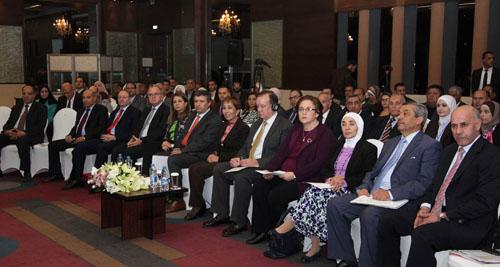You are here
Jordan marks World Population Day
By Khetam Malkawi - Jul 10,2014 - Last updated at Jul 10,2014
AMMAN — The Kingdom has witnessed several demographic changes over the past few decades that also led to a change in the age composition of its population, a Department of Statistics (DoS) report said on Thursday.
The report, issued to mark World Population Day which is annually observed on July 11, said the country’s population was 586,000 in 1952 and reached 6.530 million by the end of 2013.
However, Interior Minister Hussein Majali said last year that the Kingdom’s population ranges between 8 to 9 million as the number of Jordanians with national numbers is estimated at some 6.9 million, with around 850,000 living abroad.
According to DoS, the population growth rate dropped from 4.4 per cent between 1979 and 1994 to 2.6 per cent in 1994-2004, and another drop was witnessed in the 2004-2013 period to reach 2.2 per cent.
Healthcare services have also improved over the years, leading to a drop in infant mortality from 122 deaths for every 1,000 live births in 1952 to 17 per 1,000 in 2013.
The fertility rate has also dropped in the country to reach 3.5 children per woman in 2013, down from 5.6 children in 1990.
In the field of education, the country managed to reduce the illiteracy rate from 16.7 per cent in 1991 to 6.8 per cent in 2013.
The enrolment rate at primary education in the Kingdom stood at 98.1 per cent in the academic year 2012-2013, DoS said.
According to the UN, the theme of this year’s day is “Investing in Young People”.
“On this World Population Day, I call on all with influence to prioritise youth in development plans, strengthen partnerships with youth-led organisations, and involve young people in all decisions that affect them,” UN Secretary General Ban Ki-moon said in a message on the occasion, according to the UN website.
“By empowering today’s youth, we will lay the groundwork for a more sustainable future for generations to come,” Ban added.
Today’s 1.8 billion young people are shaping social and economic realities, challenging norms and values, and building the foundation of the world’s future, the UN said.
Yet too many young people continue to grapple with poverty, inequality and human rights violations that prevent them from reaching their personal and collective potential, it added.
In Jordan, youths are a major part of the population, numbering around 2 million, according to the UNFPA.
According to the “Demographic Opportunity Policy Document” prepared and currently being updated by the Higher Population Council (HPC), the number of young people between the ages of 18 and 21 in Jordan is expected to rise by 28.2 per cent between 2012 and 2030 while the number of those aged between 22 and 24 years is expected to increase by 46.3 per cent, according to an HPC statement.
The number of Jordanians between the ages of 25 and 29 is expected to increase by 42 per cent in the same period.
In a statement sent to The Jordan Times,
UNFPA Assistant Representative Suad Nabhan said: “On this World Population Day, I commit UNFPA’s full support to all efforts to promote the 2 million Jordanian young people’s aspirations and to place young people in Jordan at the very heart of national and global development efforts.”
UNFPA Jordan launches a “youth to youth” month-long campaign on Friday in partnership with the HPC and the Y-Peer Network in Jordan to raise awareness on the importance of the “demographic dividend”.
Various youth-interactive initiatives will be conducted in the governorates by the young people participating in the campaign.
The demographic dividend is the stage of economic growth that begins with the transition from high to low birth and death rates, according to web sources.
Related Articles
The sudden increase in the number of non-Jordanians in the Kingdom has affected population growth and fertility rates, and led to an increase in crime, an official said this week.
AMMAN — If Jordan fails to capitalise on technical and vocational training in the coming years, it will be a major setback to its endeavours
AMMAN — As of this year, there are 2.246 million individuals aged between 15 and 24 in the Kingdom, out of an estimated total population of


















